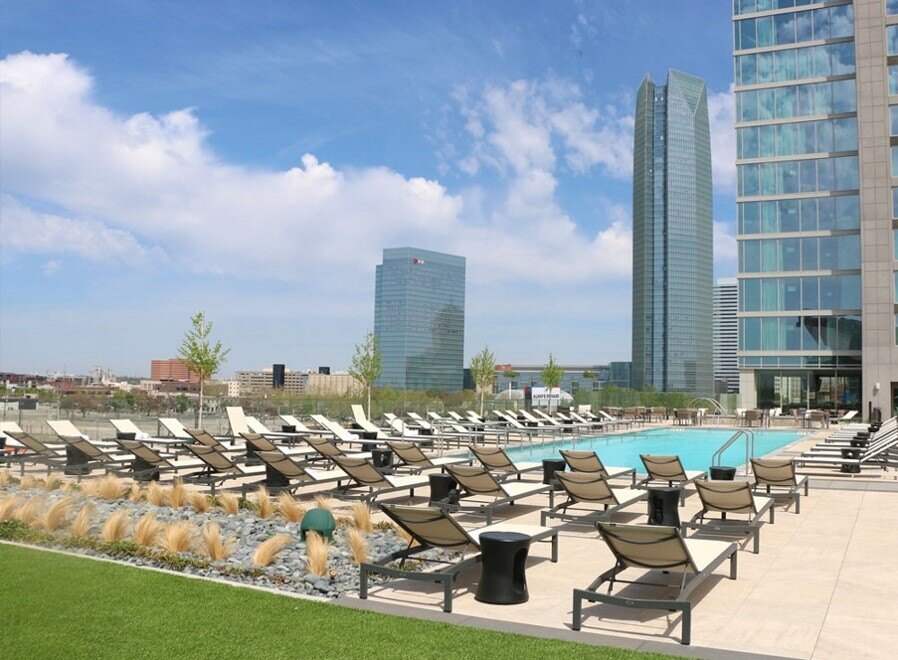Green roof systems significantly benefit urban buildings by reducing the heat island effect through temperature regulation, managing stormwater runoff, improving air quality, and providing additional insulation. They also create habitats for urban wildlife and enhance the aesthetic appeal, adding beauty to the community. Minick Materials is here to explain the benefits, different systems available, and considerations for installation on urban commercial buildings.
What is a Green Roof?
A green roof is a layer of vegetation planted on top of a waterproofing system on a flat or slightly sloped roof. It provides shade, removes heat from the air, and reduces the roof surface and surrounding air temperatures. This modern trend started when green roofs were developed in Germany in the 1960s and has since spread to many countries.
Why Are Green Roofs Important?
Green roofs offer many economic and societal benefits. They provide a rainwater buffer, purify air, reduce temperature, regulate indoor temperature, save energy, and more. Let’s dive into some specifics about the benefits of green roofs:
- Rainwater Buffer
- Air Purification
- Temperature Regulation
- Noise Reduction
- Wildlife Habitat
Rainwater Buffer
Green roofs absorb rainwater with the plants, substrate, and drainage layer. It delays rainwater discharge to the sewage system, purifies the water, and evaporates through the plants. This helps stabilize the groundwater level, reducing the risk of flooding.
Air Purification
As you may know, plants filter air and convert CO2 into oxygen. Installing a green roof on top of urban buildings helps purify the surrounding air in the community.
Regulates Temperature
Did you know plants absorb 50% of sunlight and 30% of reflected light? This helps regulate the temperature and keep the area cooler. Not only does this help an urban community stay at a regulated temperature, but it also helps the building where the roof is installed stay cooler.
Noise Reduction
A green roof acts as a sound barrier to your building. Similar to the way studios use sound-proof paneling, green roofs absorb ambient sounds, creating a quieter environment.
Wildlife Habitat
Green roofs are also natural wildlife habitats for animals. This helps the lives of animals in urban communities find a safe and environmentally friendly place to live and thrive.
Economic Benefits
The economic benefits of adding a green roof to your urban commercial building include energy savings, increased property value, and reduced maintenance costs. Energy savings are relevant because these roofs can reduce energy consumption by up to 20% and help reduce the need for air conditioning. Regarding property value, green roofs increase due to their benefits and modern design, leading to higher sales and rental prices. Because the roof isn’t a standard roof with construction that would need repairs and updates over the years, you’ll save on maintenance costs. It’s much cheaper to keep up with a green roof than a standard building roof.
Social Benefits
In addition to economic benefits, green roof systems provide social benefits, including improved mental health and well-being, enhanced aesthetics, and community engagement. Live plants offer a sense of relaxation, beauty, and zen, providing the community with calmer lifestyles.
Types of Green Roof Systems
There are three types of green roof systems available: extensive, intensive, and hybrid. Extensive roofs have shallow soil depth and low-maintenance plants and are ideal for flat roofs. Intensive roofs have deeper soil depth, a diverse plant selection, and potential for recreational use. The hybrid roofs combine extensive and intensive systems and are customizable to specific needs.
Considerations for Green Roof Installation on Urban Commercial Buildings
Before inquiring about a green roof installation, consider your roof structure, plant selection, irrigation systems, maintenance capacity, and, most importantly, local regulations and incentives. Once you’ve considered these and researched, it’s time to install a green roof!








![All About Soil Compaction: Causes, Challenges & Solutions [A Guide]](https://www.minickmaterials.com/hs-fs/hubfs/Imported_Blog_Media/plants-2411458_1920-1024x683.jpg?width=725&name=plants-2411458_1920-1024x683.jpg)
.webp?width=725&name=AdobeStock_462076409%20(1).webp)